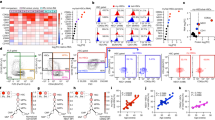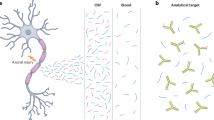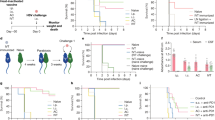Abstract
Experimental autoimmune encephalomyelitis (EAE) induced by immunization to the basic protein of central nervous system myelin (BP) is a paralytic disease in which T lymphocytes attack the individual's own central nervous system1. As the target is in white matter, EAE has been considered an experimental model of some aspects of human disease such as multiple sclerosis. To investigate whether autoimmune T lymphocytes could produce paralysis, we studied the effects on the electrophysiology of isolated nerves produced by T-lymphocyte lines reactive specifically to BP or other antigens. We now report that propagation of action potentials evoked by electrical stimulation was blocked by incubating optic nerves with specific anti-BP T cells. This blockade could be reversed for up to two hours by removing the anti-BP line cells from the optic nerve. The anti-BP line cells had no effect on conduction along allogeneic optic nerves or syngeneic peripheral nerves. This indicates that disruption of the function of myelin in neuroimmunological disease may result from an immunologically specific interaction between autoimmune T lymphocytes and myelin antigens.
This is a preview of subscription content, access via your institution
Access options
Subscribe to this journal
Receive 51 print issues and online access
$199.00 per year
only $3.90 per issue
Buy this article
- Purchase on Springer Link
- Instant access to full article PDF
Prices may be subject to local taxes which are calculated during checkout
Similar content being viewed by others
References
Paterson, P. Y. in Autoimmunity, Genetics, Immunology, Virology and Clinical Aspects (ed. Talal, N.) 643–692 (Academic, New York, 1977).
Ben-Nun, A., Wekerle, H. & Cohen, I. R., Eur. J. Immun. 11, 195–199 (1981).
Ben-Nun, A. & Cohen, I. R. J. Immun. 128, 1450–1457 (1982).
Ben-Nun, A. & Cohen, I. R. J. Immun. 129, 303–308 (1982).
Ben-Nun, A., Wekerle, H. & Cohen, I. R. Nature 292, 60–61 (1981).
Ben-Nun, A. & Cohen, I. R., Eur. J. Immun. 11, 949–852 (1981).
Brostoff, S. W., Karkhanis, Y. D., Carlo, D. J., Reuter, W. & Eylar, E. H. Brain Res. 86, 449–458 (1975).
Altman, P. C. & Katz, D. D. Inbred and Genetically Defined Strains of Laboratory Animals. Pt I, 316 (FASEB, Bethesda, 1979).
Naparstek, Y. et al. Eur. J. Immun. (in the press).
Bevan, M. Nature 269, 417–418 (1977).
Ting, J. P. Y., Shigekawa, B. L., Linthicum, D. S., Weiner, L. P. & Freilinger, J. A. Proc. natn. Acad. Sci. U.S.A. 78, 3170–3174 (1981).
Carrel, S., De Tribolet, N. & Gross, N. Eur. J. Immun. 12, 354–357 (1982).
Bornstein, M. B. & Crain, S. M. Science 148, 1242–1244 (1965).
Lumsden, C. E., Howard, L., Aparicio, S. R. & Bradbury, M. Brain Res. 93, 283–299 (1975).
LaFontaine, S., Rasminsky, M., Saida, T. & Sumner, A. J. J. Physiol., Land., 323, 287–306 (1982).
Arnason, B. G. W., Winklker, G. F. & Hadler, N. M. Lab. Invest. 21, 1–10 (1969).
Huxley, A. F. Ann. N.Y. Acad. Sci. 81, 221–246 (1959).
Rasminsky, M. in Physiology and Pathobiology of Axons (ed. Waxman, S. G.) 361–376 (Raven, New York, 1978).
Author information
Authors and Affiliations
Rights and permissions
About this article
Cite this article
Yarom, Y., Naparstek, Y., Lev-Ram, V. et al. Immunospecific inhibition of nerve conduction by T lymphocytes reactive to basic protein of myelin. Nature 303, 246–247 (1983). https://doi.org/10.1038/303246a0
Received:
Accepted:
Issue Date:
DOI: https://doi.org/10.1038/303246a0
This article is cited by
-
Autoimmune T cells protect neurons from secondary degeneration after central nervous system axotomy
Nature Medicine (1999)
-
Prolonged dynamic clinico-immunological observation of 85 patients with definite multiple sclerosis: First steps towards monitoring process activity
Journal of Neurology (1994)
-
Short term neurophysiological monitoring in multiple sclerosis bouts. Evaluation of steroid treatment
The Italian Journal of Neurological Sciences (1992)
-
The need for a new strategy for the treatment of multiple sclerosis
Journal of Neurology (1988)
-
Ia-restricted encephalitogenic T lymphocytes mediating EAE lyse autoantigen-presenting astrocytes
Nature (1986)
Comments
By submitting a comment you agree to abide by our Terms and Community Guidelines. If you find something abusive or that does not comply with our terms or guidelines please flag it as inappropriate.



